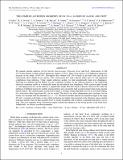THE COMPLEX ACCRETION GEOMETRY OF GX 339–4 AS SEEN BY NuSTAR AND SWIFT
Author(s)
Tomsick, J. A.; Miller, J. M.; Corbel, S.; Bachetti, M.; Boggs, S. E.; Christensen, F. E.; Craig, W. W.; Fabian, A. C.; Gandhi, P.; Hailey, C. J.; Harrison, F. A.; Kara, Erin; Kennea, Jamie A.; Madsen, Kristin K.; Pottschmidt, K.; Stern, D.; Walton, D. J.; Wilms, J.; Zhang, W. W.; Nowak, Michael A.; Grinberg, Victoria; Furst, F.; ... Show more Show less
DownloadFurst-2015-The complex accretio.pdf (939.1Kb)
PUBLISHER_POLICY
Publisher Policy
Article is made available in accordance with the publisher's policy and may be subject to US copyright law. Please refer to the publisher's site for terms of use.
Terms of use
Metadata
Show full item recordAbstract
We present spectral analyses of five Nuclear Spectroscopic Telescope Array and Swift observations of GX 339–4 taken during a failed outburst during the summer of 2013. These observations cover Eddington luminosity fractions in the range ≈0.9%–6%. Throughout this outburst GX 339–4 stayed in the hard state and all five observations show similar X-ray spectra, with a hard power law with a photon index near 1.6, and significant contribution from reflection. Using simple reflection models we find unrealistically high iron abundances. Allowing for different photon indices for the continuum incident on the reflector relative to the underlying observed continuum results in a statistically better fit and reduced iron abundances. With a photon index around 1.3, the input power law on the reflector is significantly harder than that which is directly observed. We study the influence of different emissivity profiles and geometries and consistently find an improvement when using separate photon indices. The inferred inner accretion disk radius is strongly model dependent, but we do not find evidence for a truncation radius larger than 100 r[subscript g] in any model. The data do not allow independent spin constraints, but the results are consistent with the literature (i.e., a > 0). Our best-fit models indicate an inclination angle in the range 40°–60°, consistent with limits on the orbital inclination but higher than reported in the literature using standard reflection models. The iron line around 6.4 keV is clearly broadened, and we detect a superimposed narrow core as well. This core originates from a fluorescent region outside the influence of the strong gravity of the black hole. Additionally, we discuss possible geometries.
Date issued
2015-07Department
MIT Kavli Institute for Astrophysics and Space ResearchJournal
The Astrophysical Journal
Publisher
IOP Publishing
Citation
Fürst, F., M. A. Nowak, J. A. Tomsick, J. M. Miller, S. Corbel, M. Bachetti, S. E. Boggs, et al. “THE COMPLEX ACCRETION GEOMETRY OF GX 339–4 AS SEEN BY NuSTAR AND SWIFT.” The Astrophysical Journal 808, no. 2 (July 27, 2015): 122. © 2015 The American Astronomical Society
Version: Final published version
ISSN
1538-4357
0004-637X